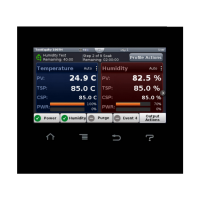Chapter 2 – Using the F4T Front Panel
TestEquity F4T Controller Page 23
Exporting/Importing Profiles and Configuration via USB
Transferring Profile Files
Profiles can be exported and imported as individual files via USB thumb drive. This is useful for
transferring profiles between different chambers and for archival purposes. The profile files
contain all the profile steps that would ordinarily be entered via the front panel or Composer
software. It does not contain any logged data.
To export a profile file to a USB thumb drive:
1. Insert a USB thumb drive into USB host port on the chamber.
2. Press the Menu button.
3. Press the File Transfer button.
4. Press Export, then press Profile.
5. A screen will pop up the names of each stored profile. Press the desired profile name to
export it. A progress bar will appear and then indicate 100% when done.
To import a profile file to a USB thumb drive:
1. Insert a USB thumb drive into USB host port on the chamber.
2. Press the Menu button.
3. Press the File Transfer button.
4. Press Import, then press Profile.
5. A screen will pop up the names of each stored profile. Press the desired profile name to
import it. A progress bar will appear and then indicate 100% when done.
Transferring Configuration Files
The F4T configuration file contains a “System Image” of all settings that determine how the
controller inputs and outputs work and how the display appears. The configuration file also
contains all profiles. It does not contain any logged data. The configuration can be exported for
archiving purposes. It can also be imported to restore the configuration from a previous archive.
! CAUTION: Configuration files are unique to each particular model chamber and must
NEVER be transferred to a different model chamber.
To export a Configuration file to a USB thumb drive:
1. Insert a USB thumb drive into USB host port on the chamber.
2. Press the Menu button.
3. Press the File Transfer button.
4. Press Export, then press Configuration.
A progress bar will appear and then indicate 100% when done.
Importing a configuration file is accomplished similar to the profile import except you select
Configuration and then select the desired configuration file.

